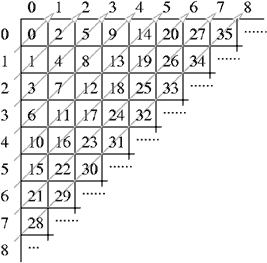当前你的浏览器版本过低,网站已在兼容模式下运行,兼容模式仅提供最小功能支持,网站样式可能显示不正常。
请尽快升级浏览器以体验网站在线编辑、在线运行等功能。
3198:Polygon Encoder
题目描述
Imagine an infinite table with rows and columns numbered using the natural numbers. The following figure shows a procedure to traverse such a table assigning a consecutive natural number to each table cell:

This enumeration of cells can be used to represent complex data types using natural numbers:
A pair of natural numbers (i, j) is represented by the number corresponding to the cell in row i and column j. For instance, the pair (3, 2) is represented by the natural number 17; this fact is noted by P2(3, 2) = 17.
The pair representation can be used to represent n-tuples. A triplet (a, b, c) is represented by P2(a, P2(b, c)). A 4-tuple (a, b, c, d) is represented by P2(a, P2(b, P2(c, d))). This procedure can be generalized for an arbitrary n:
Pn(a1, …, an) = P2(a1, Pn−1(a2, …, an)),
where Pn denotes the n-tuple representation function, n ≥ 2. For example P3(2, 0, 1) = 12.
A list of arbitrary length ‹a1, …, an› is represented by
L(‹a1, …, an›) = P2(n, Pn(a1, …, an)).
For example, L(‹0, 1›) = 12.
The Association of Convex Makers (ACM) uses this clever enumeration scheme in a polygon representation system. The system can represent a polygon, defined by integer coordinates, using a natural number as follows: given a polygon defined by a vertex sequence ‹(x1, y1), …, (xn, yn)› assign the natural number:
L(‹P2(x1, y1), …, P2(xn, yn)›).
ACM needs a program that, given a natural numbers that represents a polygon, calculates the area of the polygon. It is guaranteed that the given polygon is a simple one, i.e. its sides do not intersect.
As an example of the problem, the triangle with vertices at (1,1), (2,0) and (0,0) is codified with the number 2141. The area of this triangle is 1.
输入解释
The input consists of several test cases. Each test case is given in a single line of the input by a natural number representing a polygon. The end of the test cases is indicated with *.
输出解释
One line per test case, preserving the input order. Each output line contains a decimal number telling the area of the corresponding encoded polygon. Areas must be printed with 1 decimal place, truncating less significative decimal places.
输入样例
2141 206 157895330 *
输出样例
1.0 0.5 1.0
最后修改于 2020-10-29T06:55:28+00:00 由爬虫自动更新
共提交 0 次
通过率 --%
| 时间上限 | 内存上限 |
| 1000 | 65536 |